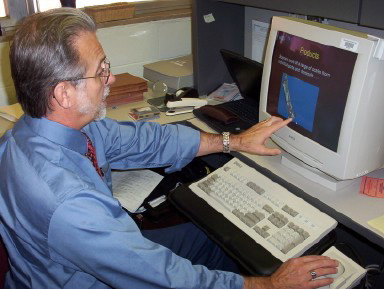Contact: Phil Hearn

Bill McAnally
Mississippi State University researchers are helping transportation officials in three states plan inland road, rail and waterway improvements to accommodate an anticipated U.S. trade boom with Latin America.
Hindsight may be 20-20, but engineering foresight is being sought to help Alabama, Mississippi and Louisiana develop intermodal systems that can absorb and disperse an expected tripling of shipments from south of the border by the year 2020.
"The issue of freight movement has tremendous implications for transportation agencies and officials nationwide," said Ray Balentine, director of intermodal planning for the Mississippi Department of Transportation. "As Latin American trade continues to grow, the transportation infrastructure needs must be addressed in order for this part of the country to take advantage of potential economic benefits."
MDOT played the leading role among transportation agencies in more than a dozen states in producing a 2001 report, the "Latin America Trade and Transportation Study," which projected that Latin American trade shipments through South Atlantic and Gulf of Mexico ports will triple by 2020.
"MDOT is among the most progressive transportation departments in the nation," said MSU civil engineering research professor Bill McAnally, who is heavily involved in the planning process. "They have been thinking intermodally for at least a decade and now everyone realizes that an efficient transportation system requires use of all five transportation modes--water, highway, rail, air and pipeline."
If the 85 percent of the Latin American trade now moving by sea increases threefold, officials warn, congestion of transportation routes is a certainty. Less certain, they said, is how that trade will be distributed by region and inland mode, since the goods-flow will be strongly affected by the ability to increase transportation infrastructure.
"It's a mixed bag," said McAnally, who spent 33 years in water resources research with the U.S. Army Corps of Engineers Research and Development Center in Vicksburg. "Every (transportation) mode works more or less in isolation and the people who are trying to put all of these things together don't have the tools they need.
"The states and the federal government build the highways and most waterways," he added. "The ports are mainly operated by local governments and some private-sector folks. The rails are totally private and the shipping lines are almost exclusively private."
That's where Mississippi State comes in. McAnally is one of three principal investigators on an interdisciplinary MSU research team currently developing computer-simulation and analysis programs that will help transportation officials decide what, where and how improvements need to be made.
"The study being conducted by MSU is an important part of the effort to provide sound and effective tools for decision-makers," said Balentine.
MDOT, the National Center for Intermodal Transportation, based at MSU and the University of Denver, and the MSU Transportation Research Center, headed by civil engineering department head Thomas White, all contributed to the $133,000 cost for phase one of the project, to be completed in December. Phase two will come later.
Principal investigators on the project in addition to McAnally are Yunlong Zhang, an MSU assistant professor of civil engineering with extensive experience in intermodal transportation modeling and simulation; and Albert J. Allen, an MSU agricultural economist and professor and expert on rural transportation. Royce O. Bowden, an MSU professor of industrial engineering and deputy director of the NCIT, developed the concept for and prototype Virtual Intermodal Transportation System simulator that is being used by the research team.
"All states need better modeling and analysis technologies, and proven intermodal policies," said Bowden. "As states adopt the modeling and analysis tools and policies derived through NCIT research programs like this one, the resulting models and information can be integrated into a national intermodal planning tool.
"Such tools also are needed to plan responses to situations such as the loss of a major port from an act of terrorism or natural disaster," he added.
Utilizing mathematical and simulation tools, the researchers plan to devise a preliminary framework for intermodal collaboration. They will consider economic, engineering, safety, and environmental factors by transportation mode as they develop various "what-if" scenarios for consideration by planners.
"To keep it manageable, phase one users are the transportation departments of just our three-state region," McAnally explained. "But you can make the plan as large or as complex as you need. You can expand it for the whole country."
According to McAnally, phase one will focus on deepwater ports at Mobile, Ala., and Gulfport, as well as along the Mississippi River in Louisiana from New Orleans to Baton Rouge. Also to be included are inland river systems such as the Mississippi and Tennessee-Tombigbee Waterway, and trunk highways and rail systems that link the ports with trade destinations.
He said a new port called "Millennium Port" has been proposed for construction closer to the Gulf, below New Orleans, to provide a modern facility "away from the congestion of the cities." Cargo can be transferred to shallow-draft vessels for transport up the Tenn-Tom inland waterway system, which has a "controlling depth of nine feet"; on the Mississippi to points beyond Baton Rouge; and for "shallow-sea shipping" east and west across the Gulf, he said.
McAnally said six major railways serving the Gulf area are considered "very much an asset" in the planning, although the rail companies and ports have experienced some difficulties in coordinating respective traffic flows. The waterways and rails are not utilized to capacity, he said, while the area's highway system "is definitely overloaded.
"Highway traffic expands to whatever capacity you build. We may have reached the limit in that regard," he said, noting federal transportation regulations require the states to clear proposed road projects with regional Metropolitan Planning Organizations, which are concerned with reducing congestion in and near urban areas.
"The MSU plan could serve as a communication tool," he predicted. "We hope that it will lead to better cooperation among all the players in our national transportation system."